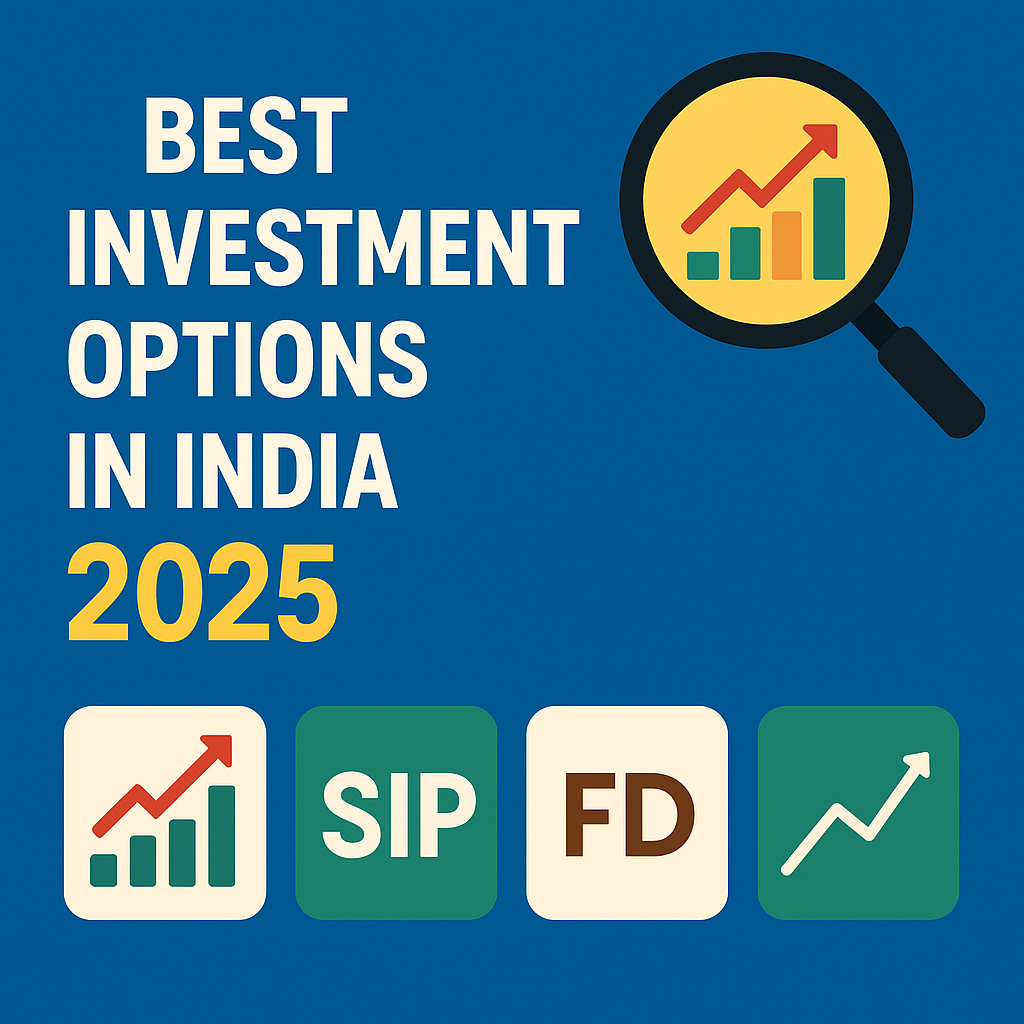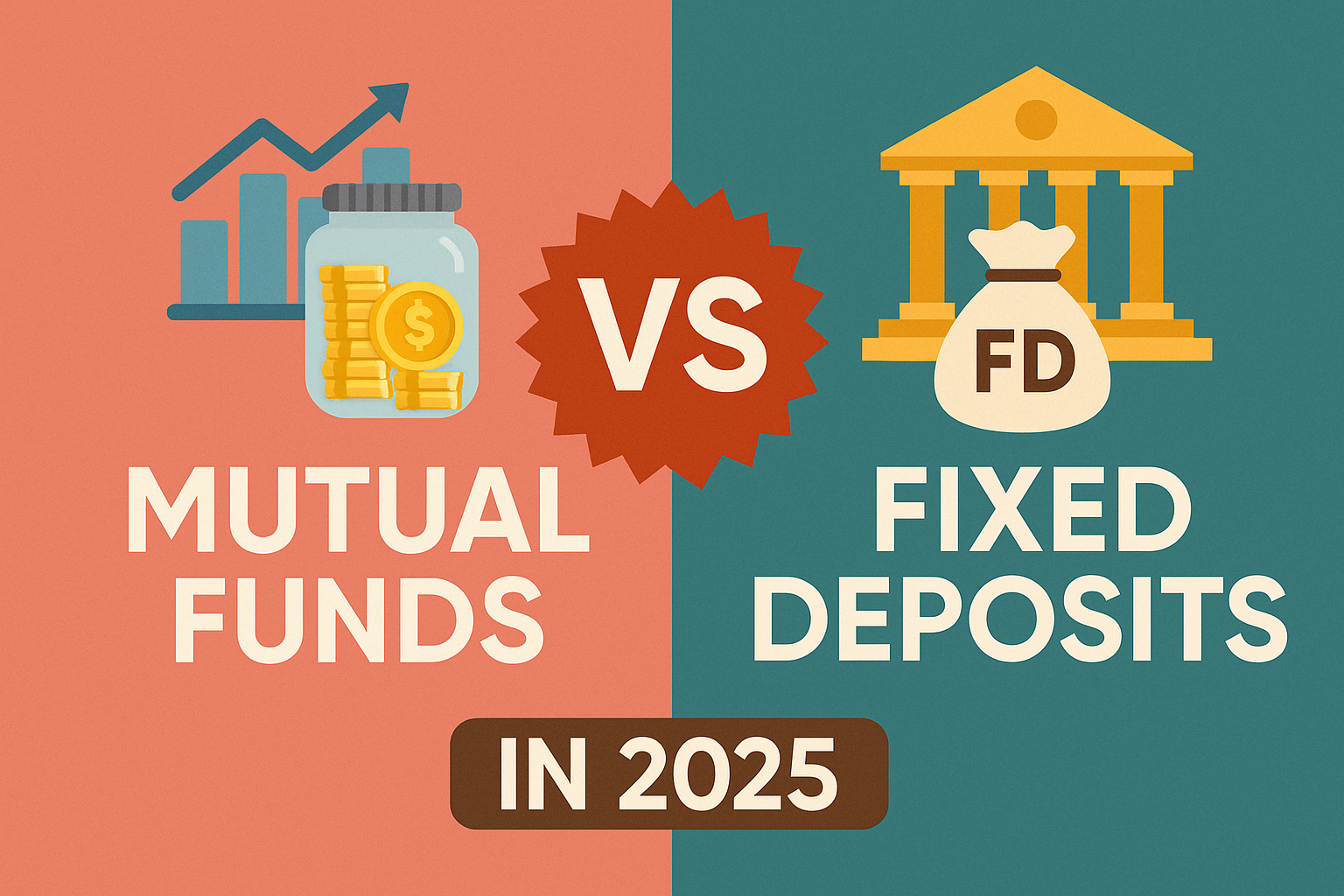2025 is shaping up as a practical year for new investors. Inflation pressures are easing, digital platforms make account setup and SIPs simple, and government schemes add an extra layer of reliability.
Start small and focus on diversification. Use fixed deposits or short-duration debt for near-term needs and SIPs in mutual funds or index ETFs for long-term growth.
Government-backed routes like PPF and NPS provide structure, tax benefits, and guaranteed returns for retirement and long-horizon goals. Gold exposure through Sovereign Gold Bonds or ETFs avoids storage hassles while adding a hedge.
This guide compares core choices — mutual funds & SIPs, stocks & ETFs, FDs, PPF, NPS, real estate & REITs, digital gold, and government bonds — and highlights tax-saving picks like ELSS and tax-saving FDs under Section 80C.
Start your investment journey in 2025 with the right mix of safe assets and growth engines that match your goals, time horizon, and risk comfort.

Key Takeaways
- 2025 offers easier entry due to lower inflation and wider digital access.
- Blend safe instruments like FDs and govt schemes with growth via SIPs.
- PPF, NPS, and ELSS serve long-term goals and give tax benefits.
- Start small, use rupee-cost averaging, and prioritize diversification.
- No single pick fits everyone—align choices with goals and timeline.
Why 2025 is a favorable year for new investors in India
Moderating inflation and clearer policy signals are creating a friendlier entry point for new savers this year. Lower price pressure and steady central bank guidance make interest-rate outlooks easier to plan around.
The market now offers a full spectrum of choices across low, medium and high risk. Short-term parking like FDs or T-Bills protects principal, while SIPs and equity funds build long-term growth through compounding.
Digital platforms and easier access
Modern apps enable instant KYC, UPI funding, fractional buying, and automated SIPs. Low fees and paperless onboarding let beginners start small and stay consistent.
Supportive government schemes
Government-backed routes such as PPF, NPS, and Sovereign Gold Bonds provide guarantees, tax benefits, and diversification. These schemes form a secure core for many investment plans.
- Moderating inflation and steady policy aid visibility for planning.
- More time in the market improves compounding and smooths volatility.
- Watch key factors: inflation prints, policy rates, and small-savings revisions.
Action tip: Combine short-term safety (FDs, T-Bills) with a monthly SIP or staggered ETF buys to manage entry and pursue your financial goals.
How to choose: risk appetite, time horizon, and financial goals
Deciding where to put your money starts with a clear view of how much risk you can accept and how long you can wait.
Risk appetite is your comfort with short-term drawdowns and the chance of permanent loss. It guides how you split capital between safe and growth assets.
Low, medium, high risk: matching options to comfort levels
Low risk: FDs, PPF, and T‑Bills protect capital and give predictable returns.
Medium risk: Debt funds, balanced funds, and corporate bonds add stability with moderate growth.
High risk: Equity funds and direct equity aim for higher returns but bring volatility.

Short-term vs long-term goals and liquidity needs
Short-term goals need liquid, low‑risk holdings to preserve funds. Long-term goals can tolerate cycles and benefit from higher-return investments.
- Create goal-based buckets: emergency reserve, near-term purchases, long-term wealth/retirement.
- Keep fees low, automate contributions (SIPs help average entry), and rebalance yearly.
- Diversify across uncorrelated assets to reduce volatility and improve risk-adjusted returns.
| Horizon | Typical instruments | Primary benefit | When to use |
|---|---|---|---|
| Short (0–3 yrs) | FDs, T‑Bills, short‑duration debt | Liquidity & capital preservation | Near purchases, tuition |
| Medium (3–7 yrs) | Balanced funds, debt funds | Stability + moderate growth | Home down payment, mid-term goals |
| Long (7+ yrs) | Equity funds, direct equity, PPF | Higher growth over cycles | Retirement, long-term wealth |
Mutual Funds and SIPs: flexible, diversified, beginner-friendly
Mutual funds give beginners a practical route to diversified exposure without picking stocks directly. They pool money to buy equities, bonds, or both, letting you access professional management with small sums.
Equity, debt, and balanced fund basics
Equity funds aim for long-term growth and higher returns but face greater volatility.
Debt funds invest in government papers and corporate bonds to offer stable income and lower volatility than stocks.
Balanced funds mix the two for moderated risk and suit moderate profiles.
Start small with SIPs
SIPs let you invest a fixed amount monthly. This enforces discipline, uses rupee-cost averaging, and helps compounding work over years.
When debt funds fit
Use debt funds for near-term goals, conservative goals, or as a ballast inside an equity-heavy plan. Check duration, credit quality, and expense ratios before you pick a fund.
- Core: low-cost index equity for growth.
- Satellite: short-duration debt for stability.
- Rebalance yearly and use a SIP calculator to set realistic targets.
Stocks and ETFs: higher return potential with guidance
For many investors, a mix of stocks and broad ETFs offers growth with controllable exposure.
Stocks represent ownership in companies. They can give strong long-term returns through capital appreciation and dividends. But stocks carry higher risk and price swings. Direct equity needs research and a tolerance for volatility.

Direct equity vs index ETFs for beginners
Direct equity rewards careful stock selection. It requires studying cash flows, valuation, and business quality. Newer investors should avoid concentration in a few names.
Index ETFs give low-cost, transparent exposure to the broader market and reduce single-company risk. They trade intraday like stocks and suit those who want simple, diversified funds-style access.
Managing volatility: staggered investing and diversification
Use staggered buys or SIP-style ETF purchases to average entry and lower timing risk. Keep position sizes modest and diversify across sectors.
- Favor core exposure to large-cap indexes rather than hot themes.
- Maintain a small debt or cash sleeve to avoid forced selling during drawdowns.
- Rebalance periodically and use dividends as a supplementary source of returns.
Guidance—via learning, advisors, or trusted research—helps manage risk and align this segment with your goals. Treat equity exposure as long-term capital and match allocation to your comfort with downside swings.
Fixed Deposits (FDs): safe parking with guaranteed returns
If you need a buffer against volatility, fixed deposits deliver fixed interest and principal protection.
FDs pay a fixed rate for a chosen term and remain unaffected by market swings. This makes them useful for near-term goals and emergency buckets.
When FDs stabilize a portfolio
FDs are foundational for conservative savers and goal-based buckets where capital safety matters. Typical tenures run several years, and laddering maturities improves liquidity and reinvestment flexibility.
Choose interest payout if you need regular income. Pick cumulative options to compound and boost maturity returns. Laddering also hedges sequence risk by funding near-term withdrawals from guaranteed sources.
- Match term lengths to your goal dates to avoid early withdrawal penalties.
- Diversify issuers for added security and use nomination for estate clarity.
- Use an FD calculator to estimate maturity values by deposit amount and term.
Remember tax on interest lowers post-tax returns, so compare small-savings rates before locking funds. Keep a separate liquid buffer for emergencies rather than tying all cash into FDs.
Public Provident Fund (PPF): long-term, tax-saving, government-backed
A government-backed savings route can be the steady core of a long-horizon plan. The public provident fund combines a sovereign guarantee with disciplined compounding over a long term.

Lock-in, tax benefits, and compounding discipline
Core strengths: PPF carries a 15-year lock-in that encourages regular savings and patience. Contributions start small, so anyone can begin building a corpus.
Tax treatment: Principal, interest, and maturity are EEE — exempt at contribution, growth, and withdrawal — which boosts effective returns and tax efficiency.
- Liquidity tools: Partial withdrawals and loans are available at set intervals to meet urgent needs without breaking the long-term plan.
- Interest: Rates are set quarterly; on-time annual deposits ensure full-year crediting and better compounding.
- Strategy: Use PPF as the fixed-income anchor while keeping short-term cash in FDs or short-duration debt for flexibility.
Practical tips: Align the 15-year maturity with milestones, consider block extensions after maturity, and set automated reminders to capture the full-year interest benefit. For conservative savers seeking guaranteed, tax-efficient returns, the provident fund remains a durable choice among investment options.
National Pension System (NPS): low-cost retirement planning
A structured pension plan can give disciplined growth and lower costs for long-term retirement goals. NPS is a government-sponsored route that mixes equities, corporate bonds, and government securities under professional management.
The scheme has Tier I for your retirement corpus with defined withdrawal rules, and an optional Tier II for flexible saving and liquidity.
Auto vs active choice and equity caps
Auto choice uses an age-based glide path that reduces equity as you grow older. It suits hands-off investors who want a steady shift toward lower risk over the years.
Active choice lets you set allocations across asset classes but must respect equity caps. That cap limits stock exposure and helps temper volatility.
“Low charges and regulated fund managers make NPS an efficient way to save for retirement over long time horizons.”
- Low fund management charges and diversified funds keep costs down.
- Tax incentives apply under 80C/80CCD, improving after-tax returns.
- At 60, partial annuitization rules apply; limited withdrawals exist for specific events.
| Feature | Tier I | Tier II |
|---|---|---|
| Purpose | Retirement corpus with withdrawal limits | Flexible savings and withdrawals |
| Liquidity | Restricted before maturity | High, like a regular brokerage account |
| Tax benefit | Yes — 80C/80CCD provisions | No special deductions |
Practical note: Combine NPS with PPF and EPF to form a diversified retirement stack. Start early, review allocations annually, and shift toward lower risk as retirement nears.
Real Estate and REITs: long-term growth and passive income
Physical property often delivers appreciation and rental income over years, but it needs larger capital, active management, and offers low liquidity.

REITs trade on exchanges and let an investor access commercial buildings with smaller amounts and better liquidity.
REITs for accessibility and diversification
Listed trusts distribute rental income regularly, blending yield with total returns potential. They reduce single-property concentration and simplify due diligence.
- Direct property: higher entry costs, transaction fees, hands-on upkeep, slower exits.
- REITs: lower minimums, exchange liquidity, transparent reporting, and scheduled payouts.
- Risks include vacancy cycles, interest-rate sensitivity, and sector concentration; diversify across trusts or REIT funds to mitigate them.
| Feature | Direct Property | REITs / REIT Funds |
|---|---|---|
| Capital required | High | Low–moderate |
| Liquidity | Low (months) | High (intraday) |
| Income profile | Rental income, variable | Regular distributions, governed by trust policy |
| Due diligence | Legal, physical, tenant checks | Financial reports, occupancy, leverage |
“Align exposure with your liquidity needs and long-term goals rather than chasing short-term market moves.”
Review occupancy, leverage, and distribution policy periodically to keep this sleeve effective inside a balanced portfolio.
Digital Gold and gold-linked options as an inflation hedge
Gold can act as a practical hedge when inflation or currency swings pressure your portfolio. Digital formats let you access that protection without physical storage, making allocation simpler for most savers.
Gold ETFs, SGBs, and when they fit
Gold ETFs trade on the exchange and mirror spot gold price. They offer liquidity, intraday access, and flexible exits, so they suit tactical moves or SIP-style accumulation.
Sovereign Gold Bonds (SGBs) are government-issued bonds denominated in grams of gold. They add a fixed coupon plus any long-term gold-linked capital returns, making them tax-efficient if held to maturity over the prescribed years.
- ETFs: easy trading, watch expense ratios and secondary-market liquidity before you buy.
- SGBs: lower custody hassle, a coupon, and government backing — but longer holding periods for full tax benefit.
- Risk note: gold rarely produces cash flow (aside from SGB interest) and can swing in the short term.
Use modest allocations as a diversifier rather than a core growth engine. Digital gold removes purity and storage concerns and works well for investors seeking stability during equity stress or geopolitical uncertainty.
Practical tip: consider SIPs in Gold ETFs to average entry and rebalance periodically so your gold weight matches long-term goals and capital needs.
Government Bonds: risk-free core for stable returns
Adding government-backed bonds can stabilize returns while preserving principal over chosen timelines. These papers form a low-default core that suits near-term goals and portfolio stabilization.

T-Bills, sovereign bonds, and laddering basics
Sovereign bonds mean you lend money to the government and receive periodic interest plus principal at maturity. Default risk is very low, making them a conservative allocation for capital preservation.
T‑Bills are short-duration papers with maturities up to one year. They are ideal for parking cash with predictable outcomes and minimal market sensitivity.
- Use laddering: hold staggered maturities to smooth reinvestment and improve liquidity over time.
- Choose direct gilts for control, gilt funds for convenience, or target-maturity funds for hands-off planning.
- Match maturities to goal timelines; longer papers give higher returns but react to rate moves.
| Feature | Direct gilt | Gilt fund / TMF |
|---|---|---|
| Convenience | Medium | High |
| Cost | Low | Varies |
| Liquidity | Depends | High |
Practical note: watch reinvestment risk and tax on coupon income. Review maturing paper periodically and roll into suitable tenors based on prevailing yields.
best investment options in India 2025 safe investment options India where to in
Match your starter plan with a simple mix of growth and protection so you learn without risking sleep. Pick clear targets: emergency cash, medium-term needs, and long-term wealth.
Starter profiles and where to begin
Conservative investor: use fixed deposits, public provident, and short-duration government paper for capital protection and steady returns.
Moderate investor: build a core of index funds via SIPs and add a stabilizing sleeve of FDs or debt funds.
Aggressive beginner: focus on index ETFs and flexi-cap equity funds while keeping liquid debt for emergencies.
“Automate contributions and start with low-cost funds; habit beats timing.”
| Profile | Core | Stabilizer |
|---|---|---|
| Conservative | PPF, fixed deposits | T‑Bills, short-duration debt |
| Moderate | Index mutual funds (SIPs) | FDs, debt funds |
| Aggressive | Index ETFs, equity funds | Liquid debt, emergency fund |
- Keep small allocations to REITs and Gold ETFs for income and inflation cover.
- Automate, review risk annually, and rebalance to keep your plan aligned with goals.
Safe vs risky investments: a quick comparison and when to choose which
A quick contrast between guaranteed papers and equity-linked routes clarifies when each suit your timeline and temperament.

Side-by-side: safety, returns, liquidity, and tax treatment
Safety: Government-backed schemes and fixed deposits emphasize principal protection and steady payouts. Equity funds and direct stocks expose you to market risk and price swings, which can mean permanent loss if held without a plan.
Returns: Predictable assets tend to give lower, steady returns. Market-linked funds often offer higher long-term returns but show wide year-to-year fluctuations and volatility.
Liquidity: FDs may charge penalties for early exit; PPF has long lock-ins. Mutual funds and ETFs usually offer faster access, though prices reflect market moves at exit.
Tax: PPF follows EEE treatment, boosting after-tax growth. Interest on fixed deposits is taxable. Equity funds follow capital gains rules that can be favorable for long-term holdings.
Diversification is key: blending FDs, PPF, NPS with MFs, ETFs
Blend a stable core—PPF, NPS, or fixed deposits—with a growth satellite of index funds or ETFs. This mix smooths returns and reduces the likelihood of forced selling during downturns.
| Aspect | Guaranteed papers | Market-linked |
|---|---|---|
| Primary benefit | Principal protection, steady payout | Higher long-term growth potential |
| Typical liquidity | Low–moderate (penalties/lock-in) | High (market-dependent) |
| Tax traits | Interest taxable; PPF = EEE | Equity LTCG rules; dividends taxed per norms |
- Pair fixed deposits and PPF/NPS for stability and predictable cashflow.
- Add low-cost index funds or ETFs for growth and to offset inflation risk.
- Rebalance annually and stress-test your plan for drawdowns and rate changes.
Practical tip: choose a mix you can hold through downturns. Cost matters—favor low-fee funds and direct bonds when possible to improve net returns and resilience.
Tax-saving picks for 2025: PPF, ELSS, NPS, and tax-saving FDs
Choose tax-saving routes that match both your cash-flow needs and long-term retirement goals. Each route balances tax relief with different lock-ins and return profiles.
Major avenues:
- Public Provident Fund: government-backed compounding with EEE tax treatment and long lock-in.
- ELSS (tax-saving mutual funds): equity exposure, 3-year lock-in, potential for higher long-term growth.
- NPS: low-cost retirement plans with an extra deduction under 80CCD(1B) beyond Section 80C.
- 5-year tax-saving FDs: fixed tenure and assured returns, but interest is taxable.
Section 80C use-cases and lock-in trade-offs
Section 80C covers many contributions, including PPF and ELSS, up to the statutory limit. Use this cap wisely across plans to get immediate tax relief.
Lock-ins matter: ELSS has a short, three-year block that aids liquidity. PPF’s 15-year structure gives certainty and EEE tax benefits but limits access.
Choosing between ELSS and PPF for long-term goals
ELSS suits those with higher risk tolerance seeking long-run wealth creation. SIPs across the financial year help average entry and lower timing risk.
Public Provident Fund suits conservative timelines and retirement-focused stacks. Its EEE treatment often improves after-tax outcomes versus taxable returns on FDs.

| Feature | PPF | ELSS | NPS |
|---|---|---|---|
| Lock-in | 15 years | 3 years | Until retirement (Tier I) |
| Tax treatment | EEE (80C) | Equity LTCG rules; 80C | 80C + 80CCD(1B) extra deduction |
| Return profile | Guaranteed (govt-set rate) | Market-linked, higher variance | Mixed (equity + bonds), low fees |
| Liquidity | Limited (partial withdrawals rules) | High after lock-in | Restricted (Tier I); Tier II flexible |
Compare post-tax yields, factor in income tax on FD interest, and favor low-cost ELSS or index-biased funds when choosing market exposure. Review allocations each year so tax-saving choices stay aligned with your goals and cash needs.
Best picks by goal and risk: safe, long-term, and high-return ideas
Split your portfolio into a guaranteed core, a growth engine, and small high-conviction satellites. This framework helps align investments with each financial goal and keeps capital working without taking undue risk.

Safe core: fixed deposits, public provident fund, and government bonds
Fixed deposits shield principal for short-term needs. Use laddering to keep liquidity predictable.
Public provident fund provides government-backed compounding for long goals and tax efficiency.
Bonds and T‑Bills offer low-risk income and help park cash for upcoming expenses.
Long-term growth: equity mutual funds, index ETFs, and NPS equity tier
Diversified equity mutual funds and low-cost index ETFs harness compounding over years. They form the growth engine for retirement and wealth creation.
Include NPS equity allocations for a retirement-focused, tax-advantaged route that balances cost and returns.
Higher return with risk: direct equity and sector/thematic funds
Direct equity and thematic funds can outperform but carry concentration risk and volatility. Keep these as satellites and cap exposure to a prudent share of the portfolio.
Use debt funds as a buffer to fund systematic withdrawals and protect against forced selling during downturns.
“Match each pick to your timeline, cap aggressive themes, and rebalance annually.”
Practical note: Control costs, favor index-like core funds, and review allocations so your plan stays aligned with goals and cash flow needs.
Beginner playbook: start small with SIPs and build a resilient portfolio
Begin with a simple monthly SIP and grow your holdings as your comfort and income rise. Start with a modest amount and let compounding and habit do the heavy lifting.
Keep one emergency buffer outside the plan so you avoid forced selling during volatility. Use auto-debit for SIPs to stay consistent and increase contributions yearly as income grows.
Sample allocations by risk appetite give a clear roadmap for new investors. Below are starter frameworks you can adapt to goals and timelines.

Starter allocations (low / medium / high)
- Low-risk starter: 60–70% fixed deposits and short-duration debt, 20–30% index mutual funds via SIPs, 5–10% gold or REITs.
- Medium-risk plan: 40–50% equity index funds and balanced funds (SIPs), 30–40% high-quality debt funds, 10–20% REITs or gold.
- High-risk approach: 70–80% equity index funds and select active funds, 10–20% debt funds for ballast, 5–10% thematic funds or REITs as satellites.
“Start small, stay consistent, and document your plan so you can follow it through market cycles.”
| Horizon | 1-year focus | 3-year focus | 5-year focus |
|---|---|---|---|
| Typical mix | 40% bonds, 40% debt funds, 20% ETFs | Balanced mix of stocks, ETFs, REITs, bonds, commodities | Higher equity weight: ETFs / mutual funds, REITs, reduced bond sleeve |
| Goal | Preserve capital, short-term needs | Growth with moderate liquidity | Long-term wealth creation |
| Notes | Keep emergency cash separate | Use staggered SIPs for entry | Favor low-cost funds for core exposure |
Practical tips: run quarterly check-ins and annual rebalancing. Even aggressive plans benefit from a small debt sleeve for resilience and dry powder during corrections.
From plan to action: align investments with your financial goals
A clear written plan that maps each goal to a timeline makes managing money easier and less stressful. Begin by listing your financial goals by horizon: 0–2 years, 3–5 years, and 5+ years. This creates distinct buckets and helps match instruments to needs.

Create goal buckets, automate, and review annually
Translate each goal into a target amount, an expected return assumption, and a monthly contribution. Use SIP and FD calculators to estimate the monthly amount and the total time required.
- Keep an emergency fund separate so long-term compounding is not interrupted.
- Automate SIPs and recurring deposits so saving happens before discretionary spending.
- Document rebalancing bands and rules for adding to positions during market drops.
| Horizon | Typical instruments | Action |
|---|---|---|
| 0–2 years | Short‑duration debt, FDs | Set target amount and avoid equity exposure |
| 3–5 years | Balanced funds, short‑term ETFs | Automate contributions, review annually |
| 5+ years | PPF, NPS, index funds | Increase equity weight for growth and plan for retirement |
Track progress on one dashboard and update the plan after income changes. Define clear exit rules: shift from equity to safer assets as the goal date nears. Consistent execution beats perfect timing—focus on process, not short-term noise.
Conclusion
A widening suite of products and smoother inflation trends make this a sensible time to act.
Digital access, supportive schemes, and clearer policy signals give new buyers practical entry points this year. Use a mix of predictable cores—like FDs, PPF, and sovereign bonds—and market-linked growth via equity funds and ETFs.
SIPs help beginners start small, harness compounding, and reduce timing risk. Add tax-saving routes such as PPF, ELSS, and NPS to improve post-tax outcomes while you build a long-term plan.
Keep diversification central and rebalance periodically. Define goal buckets, automate contributions, and track progress so short-term volatility does not derail the roadmap.
Next step: set up your first SIP, earmark guaranteed buckets, and write down your plan. Start your investment journey in 2025 with the right mix of safe and growth-focused choices tailored to your goals.
FAQ
What low-risk places can a beginner park money for steady returns?
Safe parking choices include fixed deposits (FDs), Public Provident Fund (PPF), and government bonds. FDs offer fixed interest and liquidity options, PPF provides tax benefits and long-term compounding with a 15-year lock-in, and sovereign bonds or Treasury bills deliver predictable returns with minimal credit risk. Use these as a core to protect capital and steady income.
How do mutual funds and SIPs help new investors start without large sums?
Systematic Investment Plans (SIPs) let you invest small amounts regularly into mutual funds. They enable rupee-cost averaging, reduce timing risk, and harness compounding over time. Choose diversified equity funds for growth, balanced funds for mixed risk, and debt funds for stability based on your horizon and comfort with volatility.
When should a beginner consider equity funds versus direct stocks or ETFs?
Start with equity mutual funds or broad-based index ETFs for diversified exposure and professional management. Direct stocks suit investors who can research companies and accept higher volatility. ETFs are cost-efficient for passive tracking of indices, while actively managed funds may suit those wanting expert selection without stock-picking.
What role does PPF play in retirement and tax planning?
PPF is government-backed, offers tax-free interest, and qualifies under Section 80C deductions. Its long lock-in enforces savings discipline and compounds tax-free returns, making it a strong core for retirement or long-term goals. Use PPF alongside NPS or equity exposure for balanced retirement planning.
How can the National Pension System (NPS) fit into a low-cost retirement plan?
NPS combines equity, corporate bonds, and government securities to build a retirement corpus with low fees. You can choose auto or active fund management and set equity exposure caps by age. NPS offers additional tax benefits and is efficient for disciplined, long-term pension accumulation.
Are gold-linked instruments useful for hedging inflation? Which ones to pick?
Gold can hedge inflation and diversify portfolios. Consider Sovereign Gold Bonds (SGBs) for fixed interest plus capital appreciation and Gold ETFs or digital gold for liquidity and ease of trading. Physical gold adds storage costs and lower convenience, so choose paper or digital forms for efficiency.
What’s the advantage of REITs over buying physical property for new investors?
REITs provide exposure to real estate without large capital outlay or management hassles. They offer liquidity, regular income through dividends, and diversification across commercial assets. For beginners, REITs reduce entry barriers and simplify property exposure compared with buying physical real estate.
How should I match choices to my risk appetite and time horizon?
For short-term goals (under 3 years), prioritize liquidity and capital protection: FDs, liquid funds, and short-term debt. For medium-term (3–7 years), balanced funds and conservative equity exposure work well. For long-term goals (7+ years), tilt toward equity funds, index ETFs, and NPS equity allocation to capture growth while smoothing volatility.
What tax-saving instruments should I consider while planning for 2025?
Use a combination of PPF, ELSS (equity-linked savings scheme), NPS, and tax-saving FDs under Section 80C limits. ELSS has a shorter three-year lock-in and equity growth potential, while PPF and NPS offer longer-term benefits and different tax treatments. Match lock-in and risk with your goals before committing.
How much should I allocate to core safe holdings versus growth assets?
Allocation depends on age, goals, and comfort with volatility. A simple rule: keep a conservative core (FDs, PPF, government bonds) for emergency and near-term needs, and allocate the remainder to growth assets (equity funds, ETFs) for long-term goals. Sample splits vary—30/70 for cautious savers, 50/50 for balanced profiles, and 20/80 for aggressive growth seekers.
What steps turn a plan into action for new investors?
Define clear financial goals and timelines, create goal-specific buckets, automate contributions via SIPs or standing instructions, and review allocations annually. Rebalance as goals or market conditions change and keep an emergency fund equal to 3–6 months of expenses before locking funds into long-term schemes.
Where can beginners access and manage these products digitally?
Reputable platforms include brokers like Zerodha and Groww, mutual fund platforms such as CAMS and KFintech services, and banks that offer FDs and PPF accounts online. Use platforms with strong security, transparent fees, and good customer support for seamless account opening and regular monitoring.








Comments 2